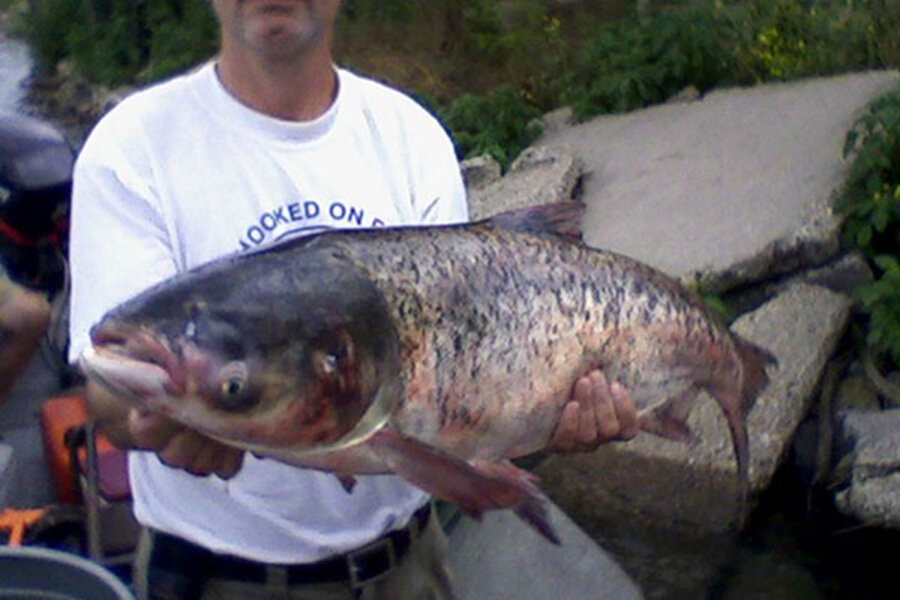Asian carp are already in Great Lakes, new report suggests
Loading...
| Chicago
A new study released this week is adding to the speculation that Asian carp are already in the Great Lakes.
Researchers report discovering traces of carp DNA in the western basin of Lake Erie as well as in a smaller lake well beyond the electric barrier that is supposed to fence the carp into the Mississippi River Basin. The scientists note that Asian carp have been caught in both locations previously – though not in large enough numbers to suggest an infestation.
The findings come as Great Lakes states battle with shipping companies and the federal government over fears that the carp could move into the Great Lakes from the Mississippi River through a canal near Chicago.
State officials say the nonnative fish – which can reproduce quickly and weigh as much as 100 pounds – would devastate the Great Lakes ecosystem and imperil a $7 billion sport-fishing industry. The city of Chicago, barging interests, and federal agencies say not enough evidence exists to prove the fish have penetrated the electric barrier in the canal, and that sealing off the canal entirely would cost billions of dollars and take years to complete.
The new study by scientists from the University of Notre Dame, The Nature Conservancy, and Central Michigan University was published Thursday in the Canadian Journal of Fisheries and Aquatic Sciences. It took water samples in various spots around the Great Lakes between September 2009 and October 2011. The researchers found traces of carp DNA – known as environmental DNA – in 58 samples.
A recent US Army Corps of Engineers report suggests that bits of the carp could have been carried beyond the barrier by fish-eating birds or aboard barges. But the research team notes that carp eDNA was found primarily in two places that were known to have live carp in the past.
One is Lake Calumet, a small lake 30 miles north of the canal where a fisherman caught a carp in 2010. The other is western Lake Erie, where two carp were caught in 2000. Federal officials have argued that those fish could have been escaped bait used by fishermen and that the low number of fish caught over such a long time suggests there is no broader threat.
But researchers say the data suggest that live carp are still there. After all, if the carp eDNA is being brought in only by birds and barges, it should be widespread – not concentrated in the two areas where carp have been caught previously.
“We know migratory birds go to those other places [where carp eDNA does not exist]. So it’s very unusual that the only places where birds or barges or people throwing fish guts out is the only place where we capture Asian carp,” says Christopher Jerde, a professor in the biological science department at Notre Dame University in South Bend, Ind., and a lead author of the report.
“We’re at the point now where we’ve had captures in the Great Lakes,” he adds. “We can safely conclude there is some evidence of some Asian carp in the Great Lakes.”
“The question is, have we gone past the tipping point,” Professor Jerde says.
He points out that the results suggest the carp populations are still largely localized and that intervention is needed to keep them in check.
But Kelly Baerwaldt, a fisheries biologist for the US Army Corps of Engineers, told The Associated Press Thursday that Jerde’s report is not conclusive and questioned why more live carp have yet to be captured beyond the barrier.
“Sure, it could be live fish, and it also could be these other things” such as waste from fish-eating birds, Ms. Baerwaldt said. “The bottom line is there’s just a lot we don’t know about eDNA.”
She said in order to accurately determine the source of an eDNA sample, several more years are necessary.
For his part, Jerde insists eDNA is a reliable tool for early detection and that the current discussion should move from debating whether or not live fish are in the Great Lakes to how to stop their proliferation.
“There’s a lot of things outside the science that is driving the science,” he says. “If we wait until the point where fish are jumping out of the water, we’re no longer in a situation where we can do something about it which can be meaningful.”








